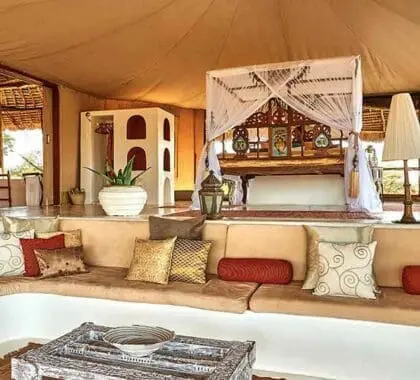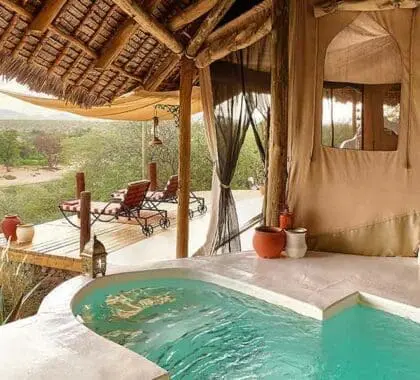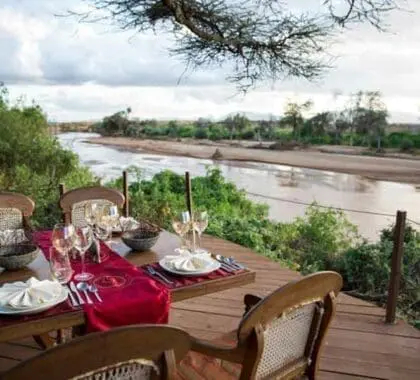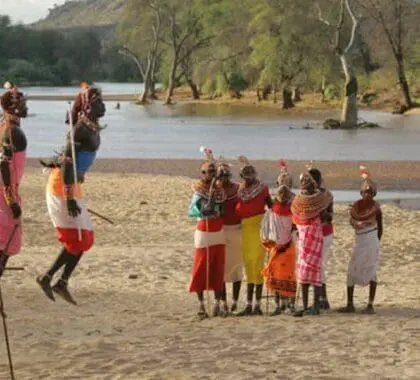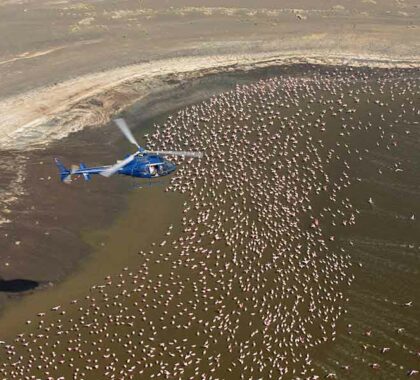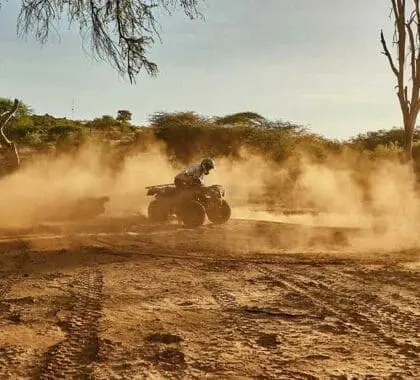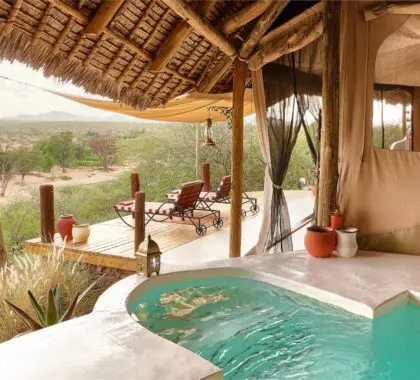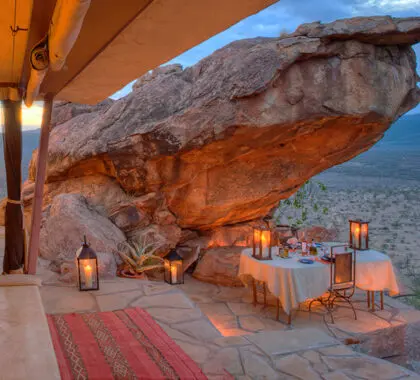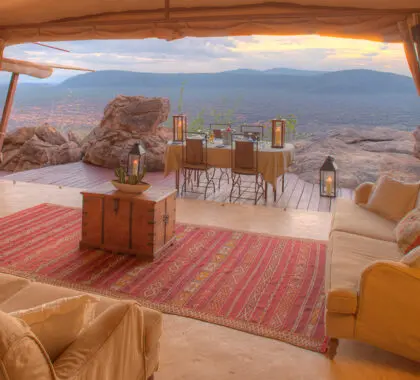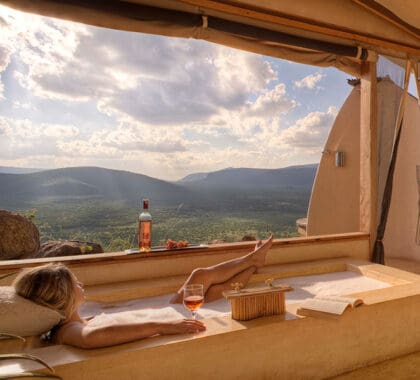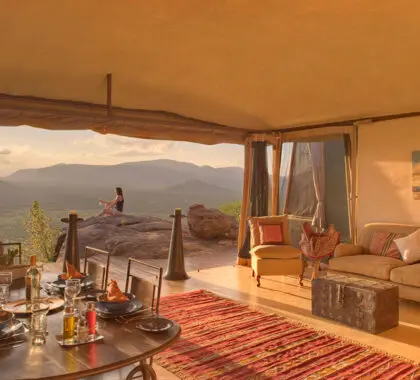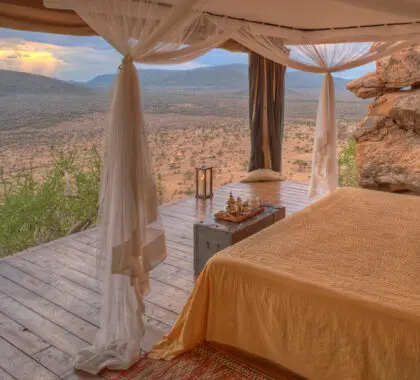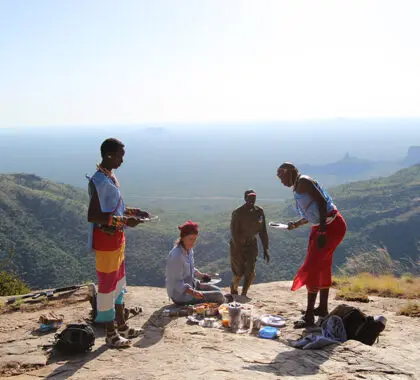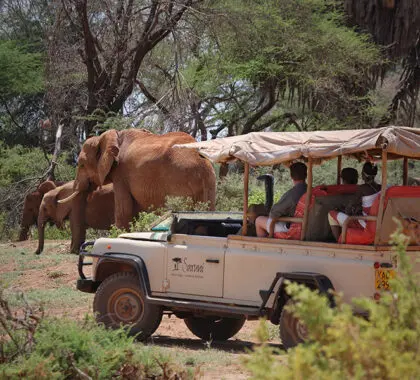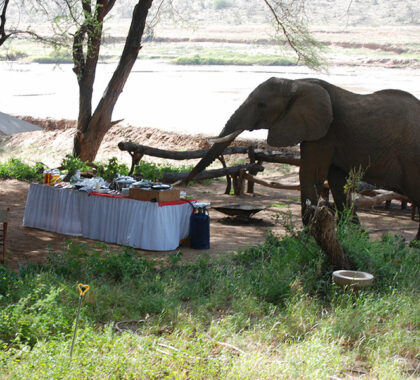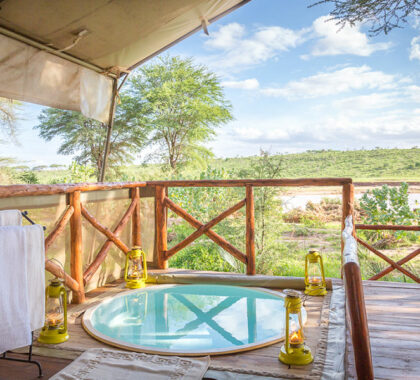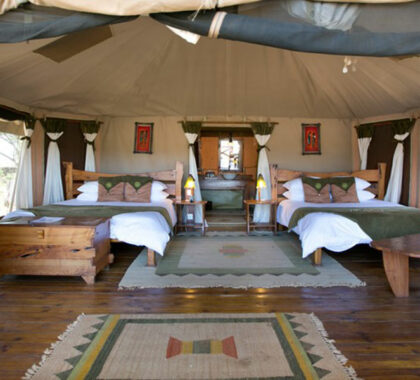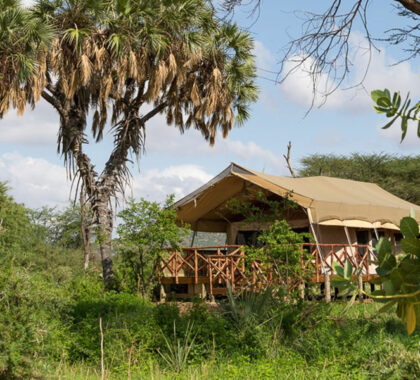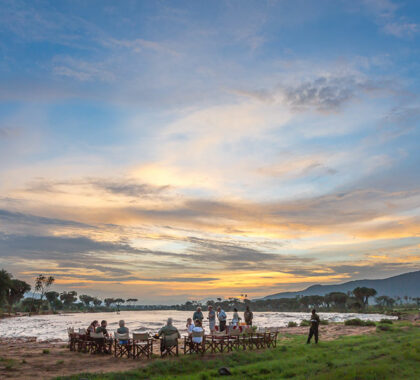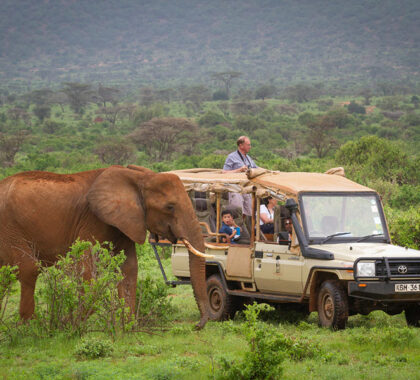Estimated reading time: 8 minutes
The Samburu National Reserve is an excellent option if you’ve been to Kenya before or are looking for more of an off-the-beaten-path destination that still has plenty of creature comforts. It's a very rewarding safari destination that offers unique experiences and excellent game viewing. There are direct flights from Nairobi’s domestic Wilson Airport and if you are coming from Lewa or Laikipia, then it is possible to do a road transfer (although it is fairly lengthy). Flying between destinations gives you more time on safari (tracking animals) and is also far less tiring than being driven.
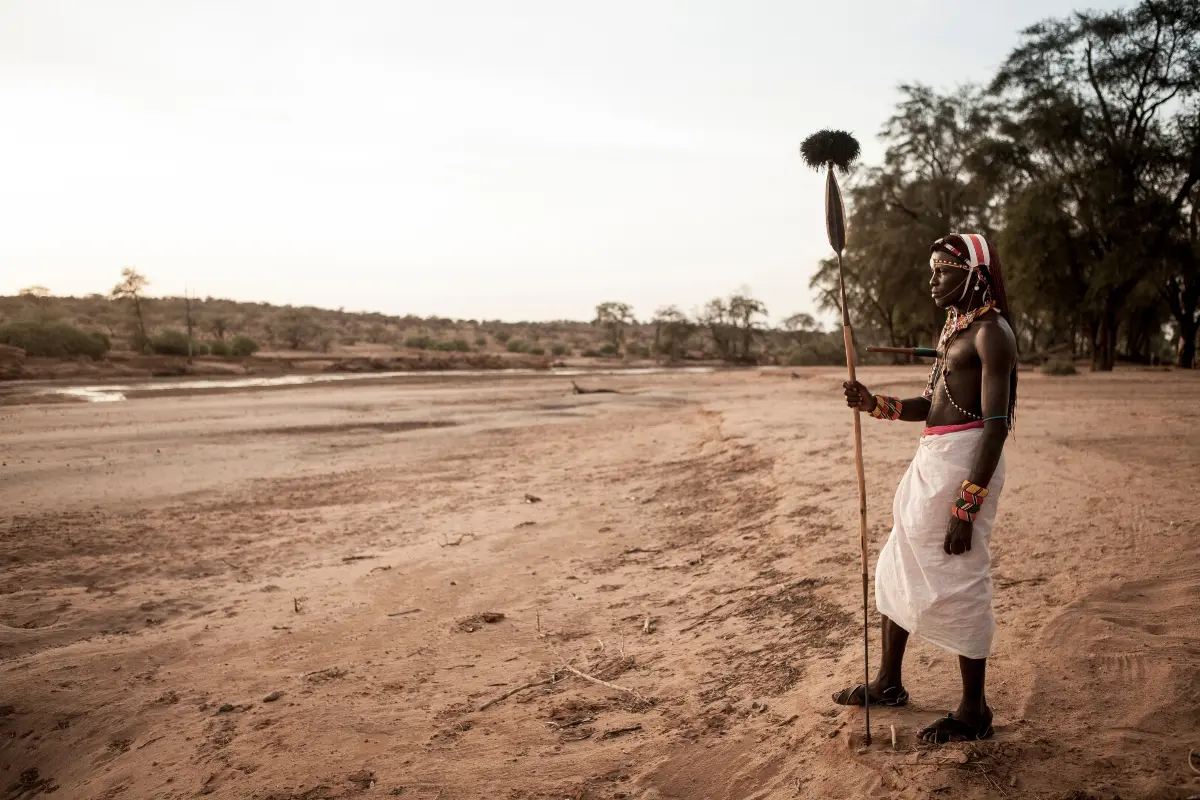
Top Things to See and Do in Samburu
- Spot gerenuk, beisa oryx, Grevy’s zebra, reticulated giraffe and Somali ostrich – the Samburu Special 5.
- Stay in accommodation that ranges from Bedouin-style tents to lodges built into and around a giant volcanic rock face.
- Learn how the Samburu way of life differs from the Maasai.
- Tick off at least 450 recorded bird species, including kori bustards, vulturine guinea fowl and secretary birds.
- Walk with Samburu guides through a hilly landscape dotted with magnificent outcrops.
- Drink in a spectacular night sky and unblemished Milky Way.
- Ditch the 4x4 and saddle up a camel to explore the scrubland.
- Be charmed by the real-life tale of a bereaved lioness adopting and protecting an orphaned gazelle – read the full true story at the entrance to Samburu National Park.
Why Go to Samburu?

Samburu is considered a gem among discerning safari goers because it is relatively uncrowded. Unlike Amboseli, it attracts few self-driving visitors over weekends or during school holidays, it also never reaches the fever pitch of the Masai Mara during the Migration, when thousands arrive to view the spectacle (that is why we prefer to stay in private conservancies in the Mara). You may have to work harder to find sightings but, when you do, the reward is that much sweeter and you’re likely to have few other vehicles around you. The big cats are found here as are unusual species like gerenuk.
It is a very satisfying destination for seasoned travellers. I met a South African woman who had been on many safaris with her husband – he was mad about giraffes and so, for his birthday, she arranged a special ‘giraffe safari’ to see as many species as possible! Samburu was top of their list for reticulated giraffes but they also enjoyed the discreet service, sensational accommodation and understated, sophisticated atmosphere.
Where is Samburu?

Samburu National Park lies in the north of Kenya, where the flat greenness of the rest of the country starts giving way to arid scrubland, kopjes and immense rocky outcrops, all centred on the meandering Ewaso Ngiro River. Far from being dull, this extraordinary landscape supports animals uniquely adapted to the drier, rockier conditions.
It is named after the Samburu people, who are nomadic pastoralists and whose traditional finery is among the most beautiful and delicate in the world. The Samburu still live in manyattas (villages) that can be moved to follow fresh grazing for their donkeys, goats and cattle. Camels were introduced at some point when trading Arabians arrived and, of course, these desert creatures thrive in this semi-desert environment. This is one of the few places in Africa where you can undertake a camel trek: set off to find wildlife, led by your capable and knowledgeable Samburu guides.
Which Animals Will I See in Samburu?
The reserve is a haven for elephants and predators like lions, leopards and wild dogs. The Samburu birdlife is abundant with over 450 recorded species like vulturine guineafowl, lesser kestrel and the taita falcon.
For animal and safari lovers, one of the biggest and most exciting reasons to visit Samburu is the quasi-endemic species found here that have adapted to the more arid and hillier conditions. While Amboseli has its impressive herds of elephants and the Masai Mara boasts millions of wildebeest during the Migration, Samburu has the Special 5 (cousins to the world-famous Big 5).
The Samburu Special 5
You may have heard about the Big 5, now meet the Samburu Special 5!
Gerenuk or giraffe gazelle

Gerenuk means ‘long necked’ in the Samburu language and they do indeed have comically long necks. They also have massive ears compared to their small heads, making them undeniably cute. Previously known as Waller’s gazelle, the Samburu people consider them to be very humble creatures that are always willing to come to the aid of fellow gerenuks. They have very strong hind legs and can stand on them for long periods while grazing leaves that other antelope are too short or giraffes too tall to reach.
Somali ostrich

While other ostrich species have pink necks and legs, Somali ostriches go in for grey-blue skin. It’s easy to spot the males in mating season – their legs and necks turn bright blue!
Grevy’s zebra

Rightly known as ‘imperial zebra’, they can live without drinking for five days in a row – a boon in dry conditions. Sadly, human demand for their beautiful hides has made them the most endangered of all zebra species as they are killed for their skin.
Reticulated giraffe

These giraffes are almost instantly recognisable because of their big, ‘liver-coloured’ rosettes that are very different to the lighter and smaller patches of their southern cousins.
Beisa oryx

Both male and female beisa oryx grow scimitar-like horns that can reach nearly a metre / three feet in length. Males will embark on ferocious battles with their horns during the rutting season to win females’ favour; occasionally you will find a male with only one horn, the other having snapped off during a fight.
When to Go: The Best Time to Visit Samburu

Samburu is a year-round destination because it does not have extremely intense rainy seasons (this also means the risk of malaria is low, but do consult your travel clinic about prophylactics). The mid-year winter is cooler and drier and coincides with peak safari season from about June to October. The dry conditions make the animals easier to find and see since they won’t move far from the Ewaso Ngiro River, one of the few sources of water.
Our Expert Advice
- Add Samburu to a peak season safari in the Masai Mara where you can see the Wildebeest Migration.
- Samburu is also very rewarding during the Green Season (about November to April), when the gentle rains make everything lush and verdant, and damp down the dust. This is also a great time to see migrant birds.
Where to Stay in Samburu
The reserve has some of the most spectacular accommodations in all of Kenya, thanks to its rocky outcrops and unusual combination of Samburu and Arabian influences.
If you are staying for more than three nights, then consider moving to a different lodge so that you get to experience a different part of the park and have different views.
SaSaab Camp
Activities Travellers Enjoyed
Elephant Bedroom Camp
Activities Travellers Enjoyed
SaSaab could be taken from the pages of A Thousand and One Nights. It’s airy, open-plan dining and living areas are strung with Arabian-style lamps, traditional carved furniture and lovely touches like amphora in arched alcoves and potted palms. Its Bedouin tent-style rooms, which are enormous and larger than some New York apartments, are also strung out along the property, which meanders down the river. While you need to be fairly fit to walk up and down the inclined pathways, the reward is maximum privacy and lovely views for every suite. Of course, you needn’t walk to the main pool since your tent has its own private plunge pool, a sun-drenched patio and an open-air bathroom. The spa is built around an internal pool and has a small gym attached to it. Further along, the freeform swimming pool is ringed with sun loungers – the nearby pizza oven can be fired up for a taste of Italy in Kenya.


Saruni Samburu is another lodge that is spread out to take in the superb views. At considerably greater altitude, the reception area is at the top of the escarpment, affording you a breath-taking vista of the Samburu plains below. Saruni Samburu takes advantage of the rock faces and massive boulders around which it is built to create a property that is connected by a series of winding paths. Once again, it helps to be fairly fit and active. During your walks between the two swimming pools, your huge suite and the communal area, be on the lookout for klipspringers – small, very shy antelope that live in pairs, mate for life and find shelter amid the rocks. Legend has it that if one dies, the other pines away from grief, too. Leopards once used these rocks as their havens and the Samburu guides can also explain how Samburu warriors hid out here for months at a time during special eating ceremonies (the young men were not allowed to return to their manyatta until they had devoured several cattle – and virtually nothing else – to build up their strength). Saruni Samburu also has a spa and is dotted with examples of exquisite Samburu jewellery: bright beads and fine silverwork are fashioned into delicate neckpieces worn by both men and women. The cuisine takes its nod from Italy – grissini, cappuccino and risotto all appear on the menu. Because of their positions on the rocks, the suites here are brick and mortar, unusual in a country renowned for its sophisticated tented camps.


Elephant Bedroom Camp is situated on the banks of the Ewaso Nyiro River and offers an authentic African safari experience in a comfortable tented setting. The camp’s spacious tents that are raised on wooden decks equipped with private plunge pools, surrounded by gorgeous doum palms. You can expect almost daily visits by a herd of elephants, and sometimes lion and leopard make their way through camp to drink from the river.


Ready to Go?
Get in touch with one of our Africa Safari Experts to help you tailor-make a Samburu safari today…

